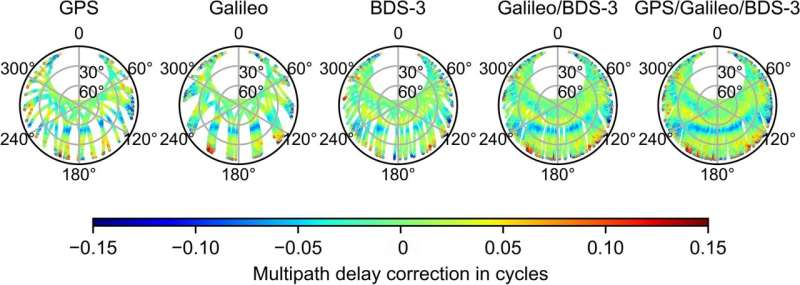This article has been reviewed according to Science X's editorial process and policies. Editors have highlighted the following attributes while ensuring the content's credibility:
fact-checked
proofread
Interoperable multipath hemispherical map: A unified approach for enhanced GNSS precision

Multipath effects, resulting from satellite signals reflecting off objects before reaching the receiver, seriously compromise the precision of satellite navigation systems. Existing solutions like Sidereal Filtering and system-specific MHMs require observations spanning at least one full cycle of satellite orbit repeat period (e.g., 10 days for Galileo) to reproduce the satellite geometry against ground stations.
As a consequence, the practicability of SF and MHM is limited due to potential station-surrounding changes over a long period. With the ongoing challenges these effects present, it is imperative to develop more advanced and flexible solutions to improve multipath modeling efficiency and GNSS positioning precision.
A new study, led by Jianghui Geng from the GNSS Research Center at Wuhan University and co-authored by experts from both the Chinese Academy of Sciences and the University of Tokyo, utilized data from 21 European stations to enhance our understanding of the GPS, Galileo, and BDS-3 systems and also highlight the efficacy of using overlap-frequency signals in applications demanding high precision.
In addition, the researchers have introduced this multipath modeling module within the open source software PRIDE PPP-AR v3.1, offering an efficient tool to mitigate multipath effects, beneficial for GNSS high-precision positioning applications. The study is published in the journal Satellite Navigation.
The investigation entailed a detailed analysis over 31 days of data from 21 European stations, assessing the newly devised MHM_GEC model against established GNSS-specific MHMs and Sidereal Filtering techniques. The findings revealed that MHM_GEC, which amalgamates data from the GPS, Galileo, and BDS-3 systems, markedly excels in mitigating multipath effects.
The MHM_GEC, constructed using 5 to 6 days of data, can enhance positioning precision by 40%, outperforming the traditional GNSS-specific MHMs and sidereal filtering established with 10 days of data. This performance boost is credited to the model's ability to effectively use overlap-frequency signals from different constellations, markedly enhancing spatial resolution, modeling efficiency, and multipath correction performance.
Dr. Yosuke Aoki, co-author and geospatial engineering expert, remarked, "The interoperable MHM model marks a significant milestone in satellite navigation technologies. It notably enhances the accuracy of positioning systems, which is essential for everything from geodesy to autonomous vehicles."
The potential impacts of this research are broad, set to transform industries that depend on precise positioning, such as maritime navigation, deformation monitoring and geodesy. By minimizing the margin of error, the interoperable MHM model not only boosts system reliability but also opens up new possibilities for applications that require exceedingly precise location data.
More information: Jianghui Geng et al, Multipath mitigation for GPS/Galileo/BDS-3 precise point positioning with overlap-frequency signals, Satellite Navigation (2024). DOI: 10.1186/s43020-024-00144-7





















